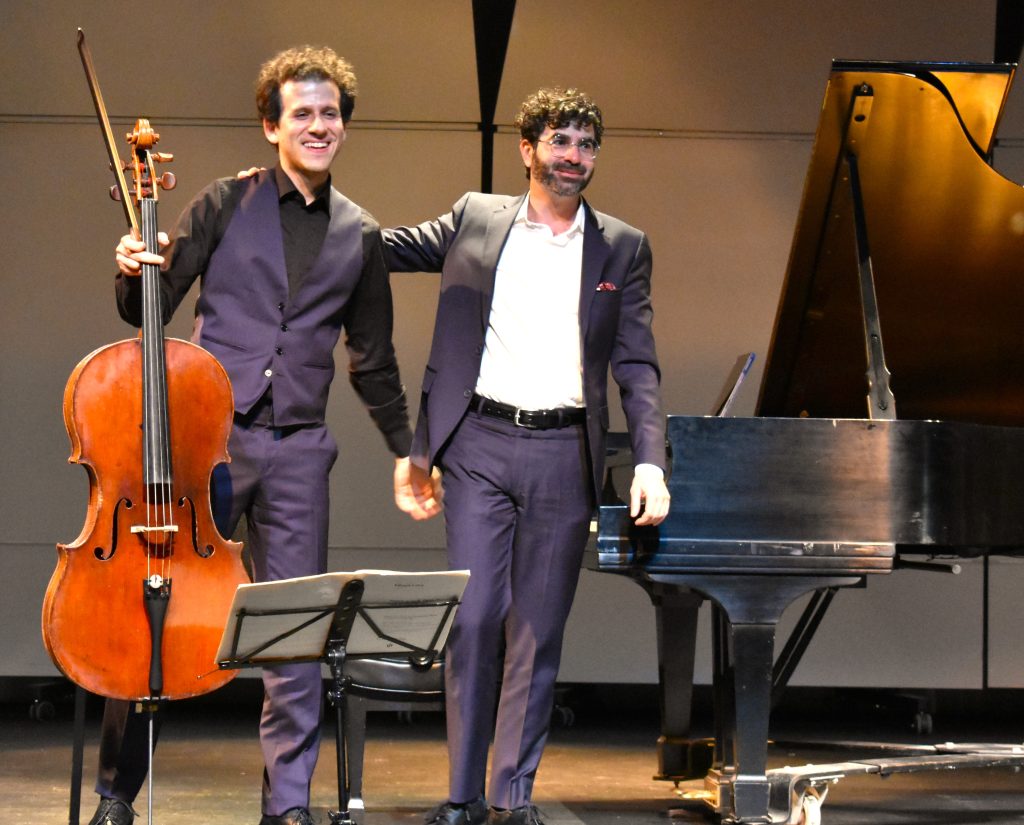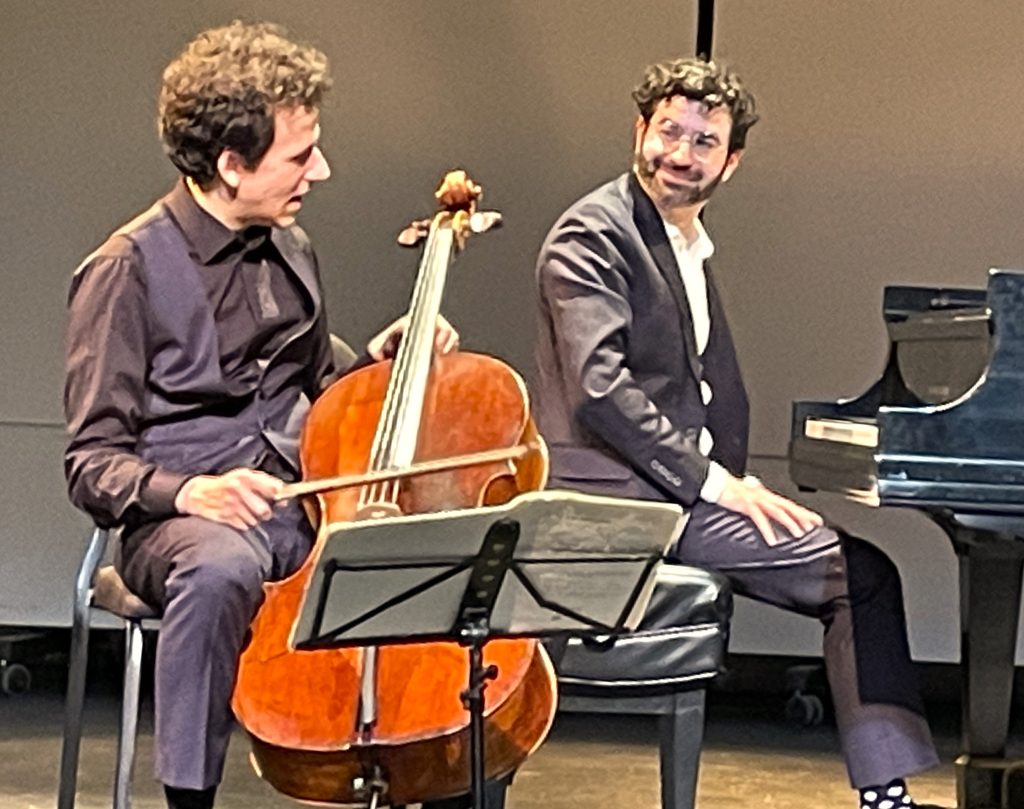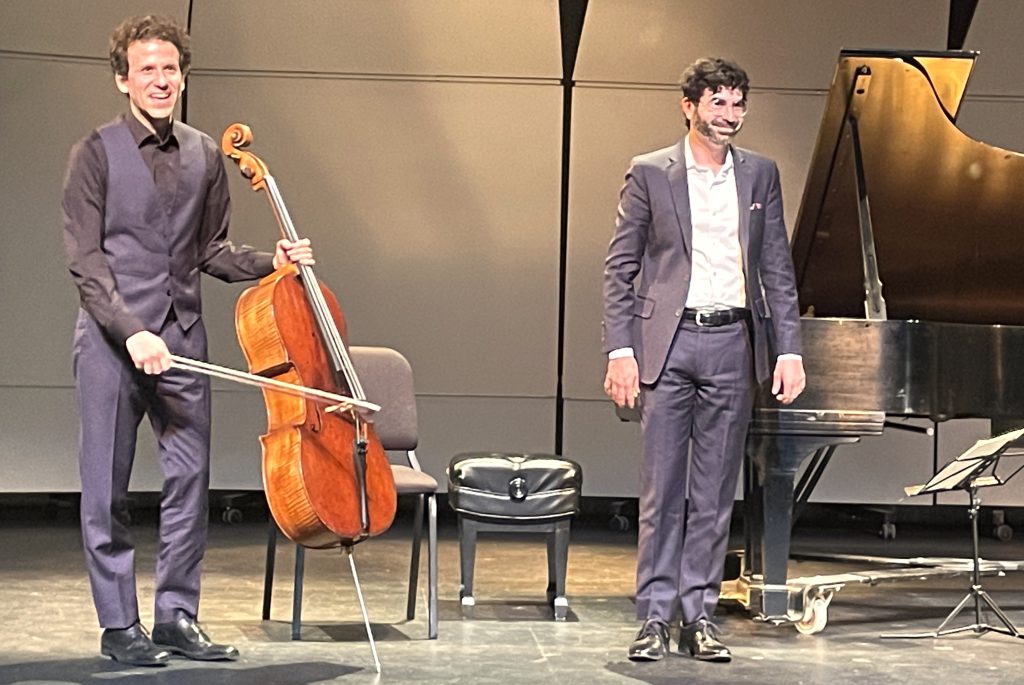
by Kevin T McEneaney
Last Friday night at the Trinity Pawling secondary school in Pawling cellist Nicholas Canellakis and pianist Michael Stephen Brown performed in Gardner Theater with an electric sensibility.
They opened with Capriccio (1948) by Lukas Foss (1922-2009) which sounded like postmodern hopscotch in its delightful whimsy. Not familiar with this work, and I was taken by its amusing and concise gymnastic athleticism with casual pyrotechnical display.
Romance in F Major, op. 36 (1874) by Camille Saint-Saëns (1835-1921) was a short, sweet “Victorian” romance of the cello falling in love with the piano. Originally written for horn and orchestra, it was adapted for cello and orchestra, then cello and piano which carried a more intimate and successful resonance.
Sonata in A Minor, op. 36 (1883) by Edvard Grieg offered virtuoso opportunities for both cello and piano; this nearly half-hour composition was the only cello-piano work that the prolific Grieg ever wrote. He dedicated the work to his brother John who was an amateur cellist. The work premiered in October of that year in Dresden. The opening Allegro featured broad folk harmonies, especially dances, yet it sounded like a torrential Spring storm pummeling the landscape. The more tranquil Andante that followed highlighted the virtues and joys of nature in summer bloom with gurgling brooks and woodland trees. The charming Allegro that concludes the work sings the praises of autumn, Greig’s favorite season of the year. The cello was the dominant instrument throughout, that being the compliment to his brother who could not perform the work at concert level; this is one of the most difficult cello works that one might aspire to play; Canellakis performed it with seamless aesthetic wizardry that conjured the immediacy of improvisation as his bow danced entrancingly between high and low. The audience responded with vigorous acclamation.

After Intermission, they opened with Clara Wiek Schumann’s “Romance” in A-flat major, the second movement of her early Piano Concerto, op. 7 (1835). This second movement is a set piece for piano and cello without the orchestra; it is an affectionate love duet between piano (Clara) and cello (Robert Schumann). The eloquent interplay between the performers captured the welded intimacy of the work.
Beau Soir (1891), a short lyrical poem by Paul Bourget put to music by Claude Debussy, followed. This work begins with the buoyant joy of youth, then concludes with sudden languorous melancholy on the tragic brevity of life.
Prelude and Dance (2017) by the pianist Brown was a solo composition for the right hand at a time when the pianist had injured his left hand. (There are about ten times the number of left-hand solo piano works than right-hand because most pianists are right-handed and are more likely to injure their right hand than left hand.) This piece rapidly traversed both high and low notes that described the bipolar predicament of the pianist: anger, frustration, despair, eventually giving way to a healing wholeness at the conclusion. Canellakis stood in the background and proffered sarcastic comments like “Are you for real?” or “What was it all for?” This was a fun, amusing excursion into the world of whimsy with humorous self-parody that provided a sense of spontaneous delight.
Romance à GF (2022) by Canellakis was a solo cello work in tribute to Gabriel Fauré. This composition brimmed with subtle, delicious nuance that recalled the myriad rainbow joys of childhood about which Gabriel was so eloquent.
Variations on a Theme by Rossini “Moses in Egypt” (1818) by Niccolò Paganini was one of Paganini’s most famous solos, just as the Rossini opera (which more resembles an oratorio) was considered the greatest opera of the nineteenth century, beloved and acclaimed by both George Sand and Honoré de Balzac This version is a showpiece for the cello and offers one of the most difficult pieces in the cello repertoire. The first half of this virtuoso piece delivers the most sorrowful melancholy possible yet swerves to the satisfaction of great joy. Canellakis was incandescent.
Bulgarian Bulge (1969) by Don Ellis was originally an orchestral jazz composition which featured many horns. This piano-cello arrangement by Canellakis offered that racing energy of Bulgarian music which usually feature eleven or thirteen measure to the bar in their folk music, but here there are 33 measures to the bar. To hear merely ten seconds of this style of music might make your hair want to stand up on end. For both piano and cello this was the closer to outflank any program closer. The audience was overwhelmed with joy!

The audience was overwhelmed with ecstatic joy!
The duo reappeared and performed an encore of George Gershwin’s Prelude no. 2 which offered a relaxing, lyrical segue to enable the audience to reconnect with their own memories and the reality of nostalgic harmonies in their lives.
This was a concert of great variety as well as virtuosity. Many of the works played are available on their new album Bromance which was just released one week ago on the ProperMusic label.